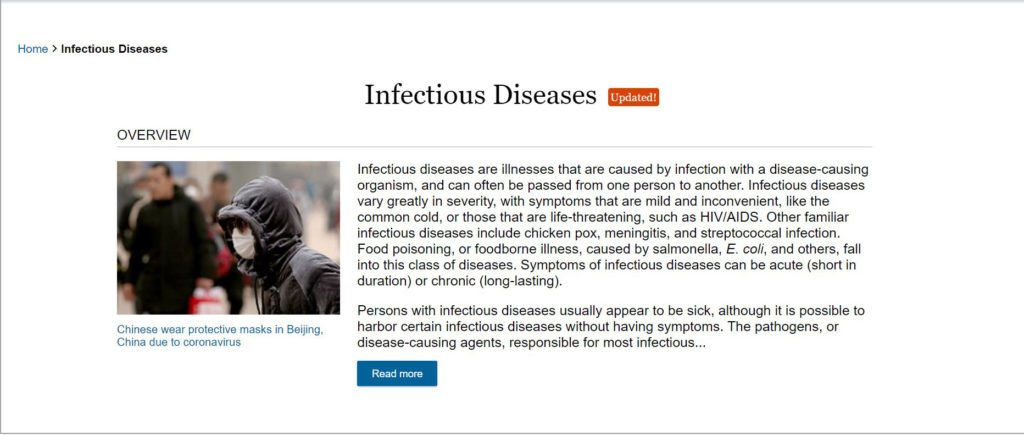| By K. Lee Lerner and Brenda Wilmoth Lerner|
Beginning in December 2019, a small cluster of cases of a pneumonia of unknown origin was reported in Wuhan, Hubei province, China. Genetic sequencing of samples taken from those cases revealed the cause to be a previously unknown coronavirus, subsequently named 2019-nCoV. Epidemiologists quickly traced the outbreak to a wholesale food market in Wuhan.
2019-nCoV is genetically part of the same clade (taxonomic classification) of coronavirus as Middle East respiratory syndrome coronavirus (MERS, or MERS-CoV), first identified after an outbreak in the Middle East in 2012, and SARS, the severe acute respiratory syndrome coronavirus (SARS-CoV) responsible for outbreaks in 2002 and 2003. With approximately a 10 percent lethality rate, the 2003 SARS outbreak resulted in 774 deaths worldwide. SARS was originally thought to have leapt from civet cats to humans, but recent genetic research also shows bats are a natural reservoir. MERS, first reported in Jordan and Saudi Arabia, is thought to have leapt from dromedary camels to humans. MERS has proved far more lethal. As of December 2019, there were 2,499 laboratory-confirmed cases of MERS worldwide, resulting in 861 associated deaths—meaning that the MERS infection was fatal in about 34 percent of cases.
2019-nCoV also apparently enters cells in the same way, via the same cell entry receptor, as SARS-CoV. Uncertainty remains as to the animal or animals responsible for infecting humans. Bat species are the most likely natural reservoir, but snakes and other animals haven’t been ruled out.

Initial data shows that 2019-nCoV is fatal in about 3.7 percent of confirmed cases. While this lethality is lower than SARS or MERS, a widespread outbreak of 2019-nCoV and the disease it causes, novel coronavirus‒infected pneumonia (NCIP), could prove more deadly and economically costly because the virus is evolving efficiency in transmitting from person to person and may ultimately infect many more people.
Although initially contracted from an animal, the 2019-nCoV outbreak is now fueled by human-to-human transmission. Estimates of the 2019-nCoV R0 (pronounced R naught) currently average about 2.6. An R0 of 2.6 means that every infected individual is infecting an average of 2.6 other people. When the R0 is greater than 1, an outbreak is self-sustaining and will increase if countermeasures like isolation, quarantine, and vaccination aren’t applied. Given the rapid spread of the virus, many epidemiologists suspect this transmissibility factor could rise over the next several weeks.
Despite levels of transparency, cooperation, and response that are generally drawing praise from the same international health community that condemned China’s response to the 2002 and 2003 SARS outbreaks, given the quick spread of the virus, many epidemiologists and other infectious disease experts openly express uncertainly as to whether China can contain the outbreak.
The virus outbreak prompted Chinese officials to institute the largest quarantine in history, with restrictions on the movements of approximately 20 million people. The unprecedented quarantining of multiple cities in the Hubei province began on January 23, 2020. China then expanded the areas of quarantine, closing schools and halting public transportation and movement into and out of quarantined areas. This requires massive dedication of national resources. Whether the widespread quarantine will be enough to end the outbreak is currently unknown.
Two preliminary studies indicating that 2019-nCoV may be transmissible before symptoms appear in those infected may, however, greatly complicate efforts to control the outbreak by quarantine. Reports are also surfacing that some people display mild symptoms but remain highly infectious. This wasn’t the case with SARS. Control of most outbreaks relies on identification and isolation of infected individuals before they can infect others. If a disease is transmissible before symptoms appear, those infected may not be detected by standard screening measures at small clinics, airports, and other checkpoints.
A global array of public health experts argue that the 2019-NCoV outbreak (aka the Wuhan coronavirus outbreak) presents a rapidly evolving epidemic challenging not only for Chinese health authorities but also for public health officials and governments in countries where the virus spreads. Multiple reports from China indicate health-care workers are dealing with high patient loads as well as local shortages of protective equipment and supplies for treatment. While the outbreak has put an emphasis on the creation and production of a vaccine effective against 2019-nCoV, such a vaccine may not be available for many months.
Epidemiological models suggest the peak of the epidemic is yet to come. Unless this novel outbreak comes in waves like most flu viruses, mathematical models predict cases will not peak before March. Accordingly, this is an evolving crisis where the numbers of the sick, the dead, and the appearance of cases in other countries may shift substantially over the new few weeks and months.
While there is strong epidemiological evidence that the current 2019-nCoV outbreak traces to the seafood market in Wuhan, the evidence isn’t conclusive. The R0 numbers observed thus far are consistent with a single-point source outbreak centered on the food market in Wuhan, but the high early case counts and a lack of direct links to the market by some early patients raise the possibility that the viral leap from animals to human hosts took place earlier and perhaps at a different place. If that proves true, it would also be consistent with the 2019-nCoV generation times observed and the superspreading behavior observed, because people may have unknowingly passed on the virus to others before their first symptoms appeared.
Meet the Authors
K. Lee Lerner and Brenda Wilmoth Lerner are the editors of Infectious Diseases: In Context, 1st edition (an Outstanding Academic Title published by Gale, a Cengage Company) and many other award-winning books and articles on science and a range of global issues. Further information about Lerner and his work may be found at https://scholar.harvard.edu/kleelerner and https://harvard.academia.edu/KLeeLerner. Additional information about Brenda Wilmoth Lerner and her work may be found at https://scholar.harvard.edu/brendawilmothlerner and https://harvard.academia.edu/brendawilmothlerner.

